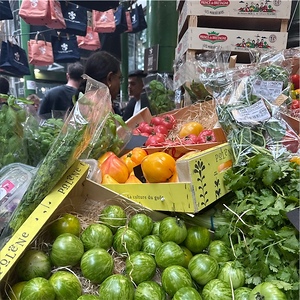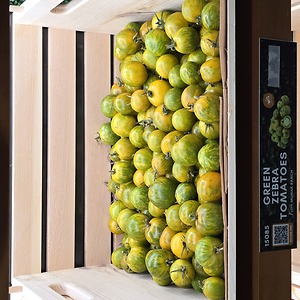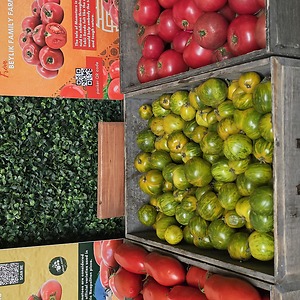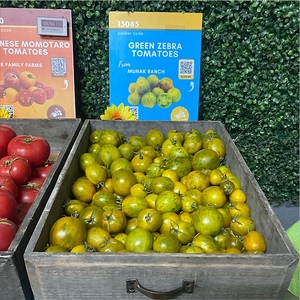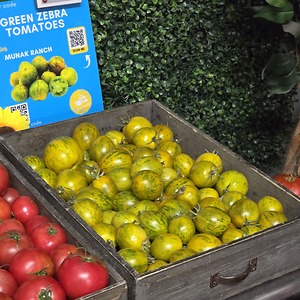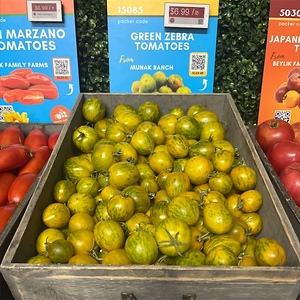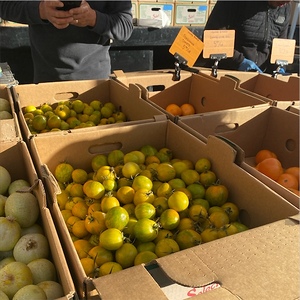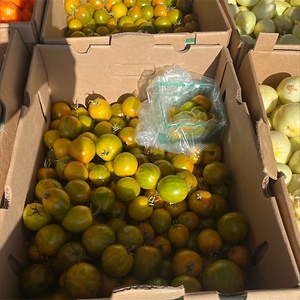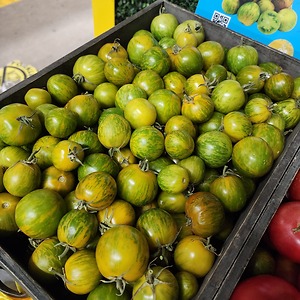

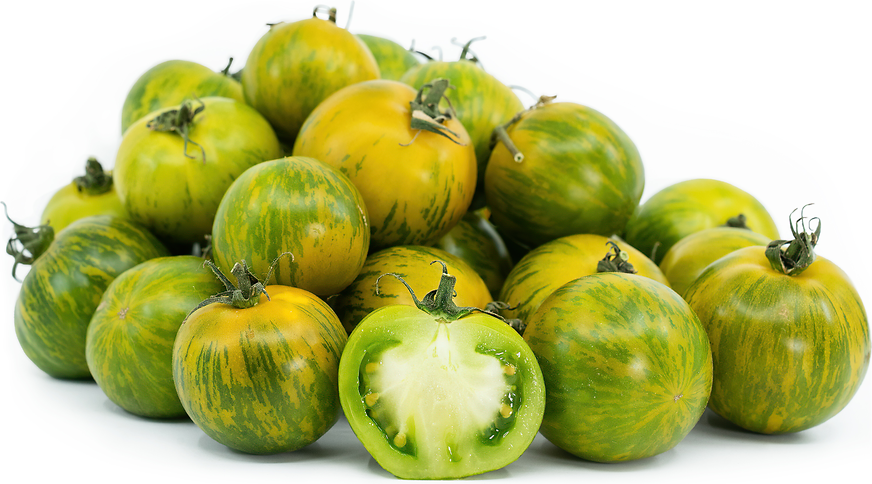
Green Zebra Tomatoes
Estimated Inventory, 10 lbs : 0
Description/Taste
Green Zebra tomatoes are small, multi-colored fruits. They are mostly round but can have a slightly flattened or oval shape, weighing around 85 to 142 grams each and measuring about 5 to 8 centimeters wide. This variety is known for its light green skin mottled with vibrant vertical stripes that cover up to 60% of the tomato. These stripes start off light green and become more yellow as the fruit matures. Their skin is shiny and smooth, feeling stiff when pressed into and attached to a small, dark green stem that emerges from the top of the fruit. Green Zebra tomatoes have pale green-white flesh that's firm and aqueous with compact gel seed pockets that hold small, yellow seeds. This flesh has a smooth texture with a juicy and crunchy bite. Green Zebra tomatoes have a tart, astringent taste when young. They transition into a balanced blend of sweet, tangy, and fruity flavors with hints of citrus and herbs as they mature.
Seasons/Availability
Green Zebra tomatoes are available in the late spring through fall.
Current Facts
Green Zebra tomatoes are botanically classified as Solanum lycopersicum along with all other varieties of tomatoes. They belong to the Solanaceae, or nightshade, family that also includes eggplants and potatoes. They are an early to mid-season hybrid that was developed as the first commercial green-when-ripe variety, as many tomatoes are initially green but transition to red when ripe. Green Zebra tomatoes are a result of crossing four different varieties of tomatoes to achieve this hybrid’s unique color and pattern, durable nature, disease resistance, and heirloom-like flavor. They develop on plants that can grow 2 meters tall and are primarily used as a culinary fruit.
Nutritional Value
The specific nutritional value of Green Zebra tomatoes is not widely known, but green tomatoes in general are rich in vitamins A and C, which are important for maintaining healthy skin, vision, and immune function. They also offer a good amount of potassium, which helps regulate blood pressure and supports proper muscle and nerve function. They contain iron and calcium, which are vital for bone health and oxygen transport in the blood. The dietary fiber in green tomatoes promotes digestive health, while their magnesium content plays a key role in energy production and maintaining normal muscle and nerve function.
Applications
Green Zebra tomatoes are best suited for raw applications. Their tangy flavor may be highlighted when they're coated in olive oil and salt. These fruits are often sliced into salads, chopped up for salsas, layered onto Caprese, or covered in herbs and cheeses as a vibrant side dish. Green Zebra tomatoes can also be blended into gazpacho or mixed with green goddess dressing. In addition to fresh applications, these tomatoes can be cooked to mellow out their acidity. Their small size makes them ideal for kebabs, hollowing out and stuffing, or quartering and adding to curries. Green Zebra tomatoes can also be lightly sautéed, slow-roasted, or breaded and fried as the sturdy nature of their flesh doesn't easily break down. This variety may also be pickled, smoked, or cooked into preserves and sauces. Green Zebra tomatoes pair well with balsamic vinegar, olive oil, herbs such as basil, oregano, cilantro, and mint, cheeses like mozzarella, goat cheese, ricotta, feta, and parmesan, avocados, jalapeños, and fruits like melons, peaches, apricots, kiwis, and cucumbers. Whole and uncut Green Zebra tomatoes will keep for 3 to 7 days when stored at room temperature. Once sliced, they should be stored in a sealed container in the refrigerator for up to two days.
Ethnic/Cultural Info
Green Zebra tomatoes started garnering attention from high-end restaurants when renowned chef Alice Waters featured them on the menu at her famous restaurant Chez Panisse in Berkley, California. Waters opened Chez Panisse in 1971 with a focus on using sustainable, organic, and in-season produce. The menu changes nightly depending on the local produce available, and each ingredient’s true flavor is celebrated and highlighted in the dishes. Water’s philosophy of using fresh, local produce has led many chefs to attribute her restaurant as one of the birthplaces of California cuisine, centered on ingredient-focused cooking with simple preparations, natural flavors, and ethical practices.
Geography/History
Green Zebra tomatoes were developed in Everett, Washington in 1983 by grower Tom Wagner. As a plant breeder, Wagner had long been intrigued by the Evergreen tomato but was frustrated at the fruit’s delicate nature when ripening. Wagner set out to create a crack-resistant, striped green tomato by crossing four heirloom varieties, one of which was the Evergreen. Wagner named the resulting fruit Green Zebra tomatoes as a nod to their unique, Zebra-like striping. This variety is not cultivated on a large commercial scale but is favored by select growers for its high yields, small size, resistance to cracking, and tangy flavor. Green Zebra tomatoes grow in warm climates with ideal temperatures between 10 and 24 degrees Celcius. They are heat and drought-tolerant but sensitive to frost. These tomatoes grew in popularity when they were featured in Wagner's Tater-Mater Seed Catalog between 1993 and 1996, achieving commercial success in both the gardening and culinary world. Today, Green Zebra tomatoes are predominately grown and distributed out of Mexico and California. They are considered to be a specialty variety among chefs and home gardeners and are primarily found in local farmer’s markets.
Recipe Ideas
Recipes that include Green Zebra Tomatoes. One
Podcast



